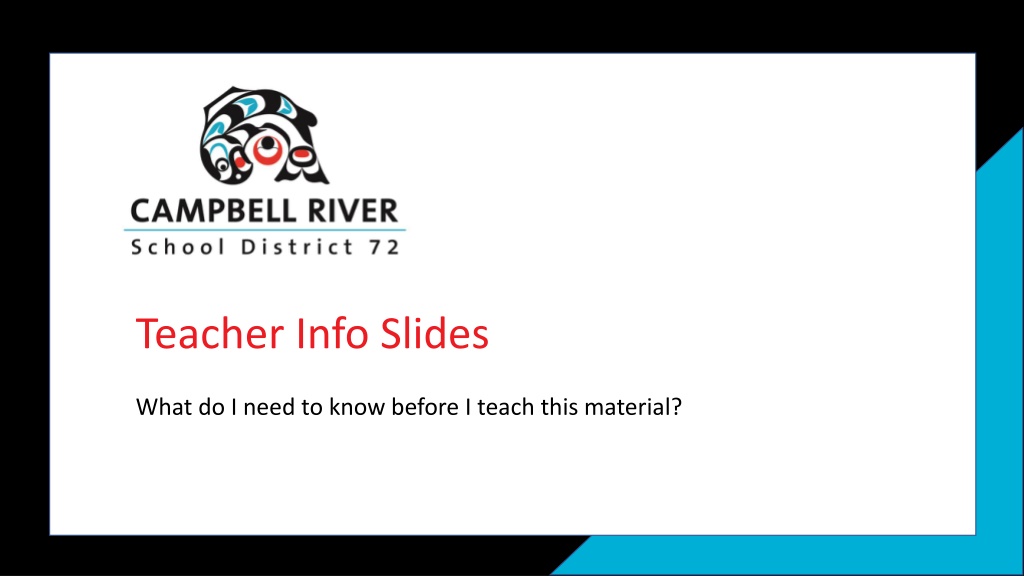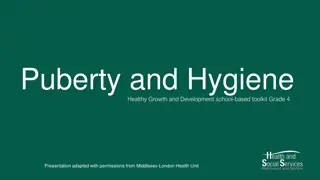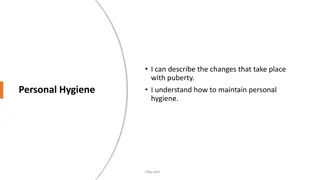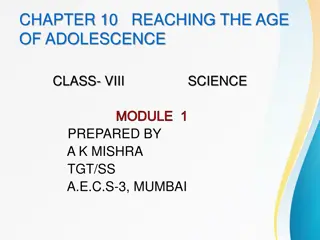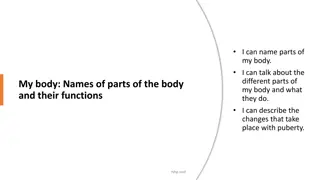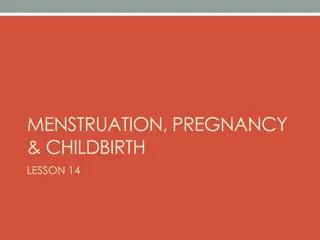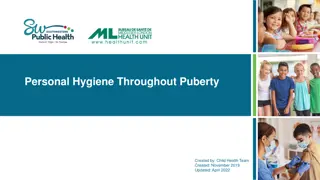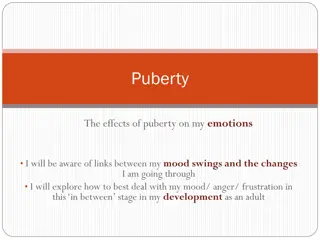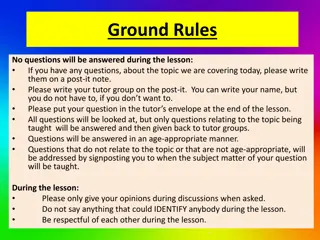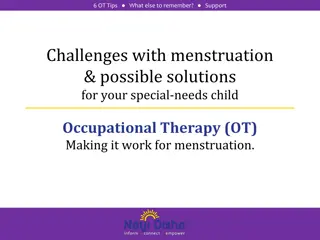Essential Information Before Teaching Puberty and Menstruation
Preparation guide for educators on teaching puberty and menstruation includes setting ground rules for answering questions, using appropriate phrases, and fostering a respectful learning environment. The content emphasizes safety, confidentiality, and media literacy to navigate discussions with students effectively.
Download Presentation

Please find below an Image/Link to download the presentation.
The content on the website is provided AS IS for your information and personal use only. It may not be sold, licensed, or shared on other websites without obtaining consent from the author. Download presentation by click this link. If you encounter any issues during the download, it is possible that the publisher has removed the file from their server.
E N D
Presentation Transcript
Teacher Info Slides What do I need to know before I teach this material?
Reminders When Answering Questions: enders When Answering Questions Set ground rules ahead of time, set up an anonymous question box and give yourself time to formulate answers for the next session, use reliable phrases, always end with a safety message or direction of a reliable resource for more information, tell students you may rephrase questions to protect confidentiality and safety of all students (no names, no questions that expose anyone)
Useful Phrases When Answering Questions: some people may, although not everyone will it s important to understand the safety of , experts believe, doctors suggest, the safest way (always end with safety as the message), ask your family what their rules are or values are about , that s an interesting question: I bet they might have an answer on one of our trusted websites: let s find out, sometimes people think of questions that will shock or gross us out but it doesn t mean they are safe, true, likely or even possible, not everything you see or hear about it is true (media literacy), In this question I wonder if there is consent of each person and if anyone would be in harm (redirect difficult questions to safety)
Health 6/7 A Year Lesson 3: Puberty Menstration
LETS REVIEW LET S REVIEW HOW DO WE BEHAVE IN HEALTH CLASS?
Ground Rules: This is Body Science! Learning about the body is fun and it helps us: Learn how to care for our own bodies Understand our body belongs to us and our rights Helps us get along with other people and not cause harm to anyone else Teaches us how to get out of unsafe situations and who to go to for help Be private: no using other people s names, or personal stories. We only talk about our bodies with people we trust, and trusted adults. This information is only appropriate for your age group and older: do not share with younger kids at lunch who may not be ready for it. Personal Values:Everyone has their own set of beliefs and family values. Even if our values aren t the same as someone else s we still show respect and honour the diversity that exists. Giggly wigglies: sometimes bodies are funny. If you have to laugh follow the 3 second rule, take a deep breath and look at the ground until you can join the group again.
Ground Rules continued: Use scientific terms and words: slang is ok, but always use scientific word as well. Using scientific words teaches a universal language of health. Interesting : doctors never say things are gross, or say ewww . Instead they say interesting it s a good word to use when we don t know what to say! No personal questions. This rule saves a lot of embarrassing moments. It s ok for students and teachers to not answer personal questions. All other questions are ok: there is no such thing as a bad question in health class. There is a time and a place for questions though. Always have a piece of scrap paper out for you to write down questions that may come up so you can ask them at the appropriate time or submit it anonymously to the question box. Support: sometimes different feelings may come up and you might need to talk with a counselor or teacher after the lesson.
The classroom is a safe spot for you to share your thoughts and feelings. We have rules, because we want to make sure everyone is able to share their feelings without fear.
Today you will learn about the anatomy of a female (person with a vulva) menstruation changes in the female body
Learning Objective I will be able to describe the process of menstruation, identify parts of the female reproductive system, and learn what to do when menstruation happens. At the end of the health ed. unit, I will be able to identify and differentiate anatomy, understand and recognize physical emotional changes, and discuss the changes in my body in a mature, respectful way.
What is Puberty? Talk at your tables to review our last lesson.
What changes happen to people with vulvas? Grow taller Bones grow Fat content increases in breasts and hips, making your body curvier Hair and skin become oily and you may get pimples Breasts get larger
What changes happen to people with vulvas? Hair grows under armpits and in pubic area Voice gets a little deeper May sweat more Menstruation (period) begins Mood swings
My breasts are getting larger! What do I do? Might want to wear a training bra (also called a bralette or starter bra) These are for people who are just beginning to develop their breasts and cannot yet fill out a standard bra
Changes in bra size Your breasts will continue to grow until you reach adulthood Weight gain or loss may affect your bra size
Different types of bras You can have different types of bras for different occassions. Training bras Underwire bras most support, good for women with larger breasts Soft-cup bras most comfortable, good for women with smaller breasts Sports bras good for active girls and women
People with a Vulva Fallopian Tube Ovaries Uterus Cervix Vagina
People with a Vulva Fallopian Tube Ovary Uterus Bladder Cervix Clitoris Rectum Urethra Vaginal Opening
ACTIVITY: Label Vulva Label the parts of the Vulva
So What Are Periods and Why Do They Happen? A person with a vulva is born with hundreds of thousands of tiny eggs, called ova one is called an ovum At puberty, hormones tell the ovaries it is time to start releasing an ova every month Usually one egg at a time (usually once a month) develops and is released from an ovary
What Are Periods and Why Do They Happen? At the same time, the uterus starts to grow a thick lining on the inside wall The lining has lots of tiny blood vessels The lining is there to protect and feed an egg that has combined with a sperm to form a fertilized egg
So What Are Periods and Why Do They Happen? If an egg does not meet a sperm, the lining is not needed. It breaks up Mixed with some blood it comes out the uterus into the vagina and then out the vaginal opening This is called menstruation but lots of females just call it their period.
Menstrual Cycle If a person with a vulva is not pregnant: then her ovary releases another egg uterus lining build ups another period This is called the menstrual cycle People have periods once a month.
When will I get my period? No exact start time Usually happens around the age of 9-13 Depends on diet and nutrition May see some white or yellow discharge in underwear before period begins How long will the bleeding last? Each person is different. It can vary from 3 8 days During a period you will only lose a few tablespoons to about half a cup of blood in that time not a lot
How often will I get a period? At first there may not be any pattern to when you will get your next period Most women eventually have a regular cycle The length of a cycle is from the first day of bleeding one month to the first day of bleeding the next time it happens Each person is different may have a period every 23 days, some every 28 days and some every 35 days Lots of girls keep a calendar to help them keep track of when they have their period and how long it lasts.
What Do I do When I Get My Period? Pads or tampons are used to catch the blood that comes from the vagina Pads are made of material that absorbs the blood Most have a sticky strip on one side to hold the pad to the underwear Pads come in a variety of sizes and shapes
Tampons A tampon made of soft material that fits inside the vagina to absorb the blood Some people like to use tampons, especially if they are doing physical activities, but pads are fine too They are good if you re going swimming Some people find them painful to insert: if so wait until older to go into the water
Pads are a lining that go over your underwear Cannot be used for swimming have a sticky strip on one side to hold the pad to the underwear come in a variety of sizes and shapes
VIDEO: Period Hygiene: Tampons, Pads and Menstrual Cups
ACTIVITY: PERIOD CHALLENGE Answer every question correctly without the help of the people with ovaries 1. What age do girls normally start their period a. starts between age 8-16 2. How often does it come a. about once a month 3. Right before her period she gets some pain in her lower abdomen, what s that called a. cramps 4. How many days does it last a. about 3-8 days 5. How much fluid (water, special tissues, and blood) leave the body every month a. about 3 tablespoons of fluid 6. So it doesn t get on their underwear what can they wear to catch the fluid a. pads, panty liners, tampons, Diva Cups, the new period underwear like Thinx/Lunapanties etc 7. What would a girl use if there weren t any supplies at her home a. toilet paper short term. 8. Where in a school can she get pads if she gets her period at school a. In the bathroom, counselors, or the front office 9. What adults could someone talk to if they had questions about periods a. Teachers, counselors, principals, EAs, parents, nurses, doctors etc
